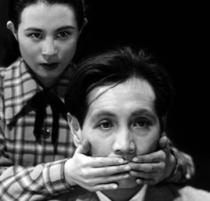 Welcome to the 13th edition of the Akira Kurosawa Online Film Club! Yes, a year has already passed since we began with Rashomon, and what a wonderful year it has been!
Welcome to the 13th edition of the Akira Kurosawa Online Film Club! Yes, a year has already passed since we began with Rashomon, and what a wonderful year it has been!
But, forward we shall soldier, with this month’s target set on The Idiot, Kurosawa’s 1951 film perhaps best known for two things: one, it is often considered Kurosawa’s weakest effort, and two, the film was heavily re-edited by the studio (Shochiku), which pressured Kurosawa to slash off almost two hours off its running time. To the best of everyone’s knowledge, and despite Kurosawa’s attempts in the early 90s to dig up the original negatives, the only version that exists today is the edited 166 minute cut which some have deemed incoherent and difficult to follow.
That is, however, not the only point of criticism typically launched against the movie. An adaptation of Dostoevsky’s novel of the same name, The Idiot has often been viewed in terms of its relationship with the source text. While Kurosawa’s adaptation is on the surface very faithful to the book, many (starting with Richie) have criticised it for being too faithful to the story, while at the same time losing not only the underlying spirit of the novel, but also hampered its own cinematic qualities as a movie.
But, despite its prevalence in the literature, this is obviously not the only way in which to approach the work. Yoshimoto in particular reminds us of this, and encourages us to consider The Idiot as “an occasion to ask some fundamental questions concerning translation between different artistic media, cultures, and historical periods” (192). Yoshimoto further goes on to note the film’s prominent use of close-ups and “over-acting”, especially in the case of actress Setsuko Hara whose performance here is compared to those that she has given under Yasujiro Ozu, thus possibly giving us a glimpse of the different methods of film making employed by Kurosawa and Ozu, arguably the two best known Japanese film makers of all time.
For Kurosawa himself, The Idiot seemed to remain a positive memory despite the problems with its production and the hostile reviews that followed its release. From all of his films, he claimed to have received most letters for The Idiot, and all in all considered that he had made an entertaining film, and not only succeeded in what he had wanted to do with the source material, but had also become a much stronger film maker as a result.
But enough about the reception that the film has received before us. The floor, good people of AkiraKurosawa.info, is now yours.






It rather unfortunate no “directors cut” exist. I do wonder if Shochiku can be fully to blame for what is largely a forgettable film. It would go against the usually well done pacing of Kurosawa, but to think his cut would near 5 hours, you have to wonder if at any giving time, does the film do anything.
Adaptation is no easy challenge, and perhaps Kurosawa got caught up in following the book too faithfully, which typically makes for an awful film. On the other hand, giving Kurosawa accomplishment and a time period where we see Kurosawa finding his “method”. I’ll have to maintain the belief Shochiku is to sole blame, as studios never make good directors-or good anything for that matter.
Though to back track, some choices of directing, seems to say Kurosawa was still stumbling. I guess only Kurosawa’s cut could answer.
Is the year script finished and production started known?